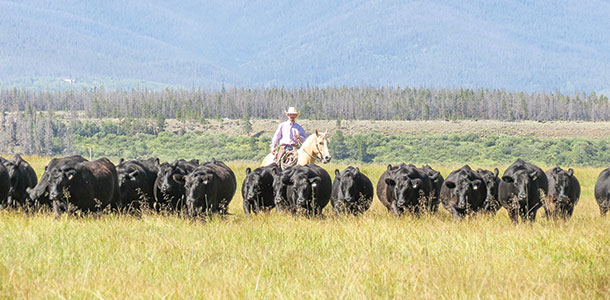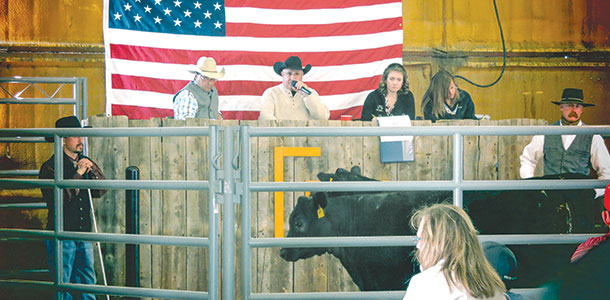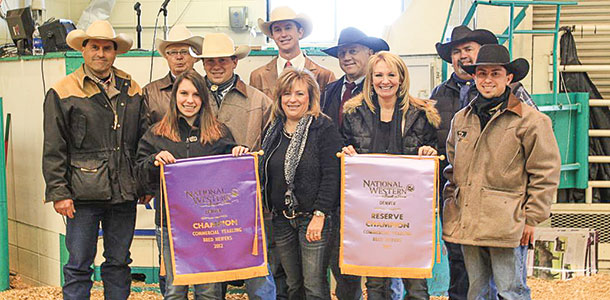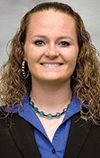However, the foundation of the National Western Stock Show was not in show cattle – but in commercial cattle.
“National Western started as a pen show in the yards primarily and migrated into a place where the commercial man would come and buy a lot of their bulls for this high-plains area. Over the years, it has continued the sale with the commercial female sale.
We have put a lot of effort into the commercial female sale the last few years,” says Marshall Ernst, senior director of livestock operations.
“Last year, we had 18 pens, and we should have 20 to 22 pens this year. Producers can exhibit 10 and bring 11. We feel this year the quality is better, and we put together a glossy catalog. Our goal is to get that sale to be a million-dollar-grossing sale.”
The commercial female sale features all of the heifers that are entered into the commercial female pen show, which includes a carload (10 head) of cattle. The cattle are judged in the pen as they are.
“It’s one of the oldest, traditional parts, and how the stock show got started. Regular ranchers show up with a carload of calves and compete within ourselves for who has the best ranch cattle. Our deal is not for show. They are more real-life production cattle where longevity is important.
"There are a lot of things that go into what we do, and that’s what is so appealing about it,” says Terry Walter, of Walter Angus, who has competed in the commercial female show for many years.

Walter Angus, located in Hudson, Colorado, raises both commercial and registered Angus cattle. “Originally, why we were going to the effort to show was to get our name out there. It’s done a good job of that.
“For a few years, before a lot of people knew of us, we were able to put our banner up and say we have good cattle. This show has helped us get our name out,” Walter explains.
Producers can bring bred or open heifers, and every animal that is brought down is sold in the sale. One of the most important features in these cattle is conformation, as well as consistency.
“The main deal down there is that they have good conformation. They need to have good feet, legs, udder, rib and that nice rear end. The judges don’t take into consideration EPD and DNA testing, so it’s more or less based on phenotype.
“We give a description on their breeding and what they are bred to, and that’s a real true description. It is mainly spring-born-type calves that have been weaned and aren’t quite a year old,” Walter says.

He continues, “There were a lot of years in there that we brought yearlings and won with those. The last five years, we took breds down. We get these heifers back from the mountains the end of October, then we preg check, then we DNA for carcass with ribeye and intramuscular fat, and then we pick which heifers we want to take.”
Consistency is important as well for the set of 10. “The conformation needs to be the same, and that’s one of the big things on all 10 heifers. If you have one that is off, you have to leave her at home. The judges, and the buyers, want that consistency from heifer to heifer,” Walter says.
Selecting the best
Deciding which heifers to take is challenging because nearly every producer keeps their very best heifers on the ranch, and Walter Angus is no exception to this.
“We never let our best heifers off our place. Those are protected here, and we don’t let them out at any price. However, you need to go down there with excellent cattle to win it, so no one takes their low ends. That’s the hard part, is figuring out your middle cut, and taking the top of those,” Walter explains.

To the Walters, functionality is key. “We need our cattle to survive in multiple environments and be functional. We have rugged cattle that are for production and function. We don’t overfeed anything, and that’s our other big selling point for both commercial and registered stock.
“Our philosophy is you need to survive on pasture. They aren’t looking for the feed truck, even in bad weather,” he states.
He adds, “When they are judging these things, the potential buyers will come through after the judges, and they will figure out disposition and how they were developed by what you have outside of the pen in terms of feed.”
The cattle are shown loose in a pen, with little fitting. “It used to be that you couldn’t do anything to them except brush them or blow them off. Now they are letting us torch them, but you can’t do true fitting. You can just clean up their head a little bit,” Walter says.
The cattle are halter-broken and come straight off the ranch. “They are unbroken and are shown in a pen. They are all brought through on random and they are judged, re-penned and the judges go back for a final evaluation.
“There are three judges, and they put their scores together and that’s how they determine a winner and the order in which the cattle are sold. It’s about what is most functional,” he states.
Heifer Mart
Another way commercial breeders can showcase their heifers is through the Heifer Mart, which was started last year. “It came to be based on some of our exhibitor and consignor requests, who wanted a place to display and merchandise females for their breeding program,” Ernst says.
He continues, “With the shortage of cattle, it’s a blessing and a curse. Selling off the farm or ranch isn’t always easy. It is an opportunity for producers to bring in three, five or 10 females, and they can be bred or open, and producers can use the Heifer Mart to display their program or sell private treaty.”
The Heifer Mart does not have a show associated with it. “We believe there are a lot of people who want to exhibit at National Western Stock Show, but they may not want to jump into the super-competitive shows. The Heifer Mart is a non-threatening way for them to bring their cattle and show them off,” Ernst explains.
He adds, “It allows buyers to buy groups of females who are more consistent if they choose to buy several. It’s a win-win for both sides of the equation.”
Last year was the first year of the Heifer Mart. “Farmers and ranchers need to see this to believe it. It will be held south of the stockyard arena. We have new tie rails and it’s leveled off. We felt that was an underutilized area, and we are hopeful we will have a large number this year,” he says. ![]()
Robyn Scherer is a freelance writer based in Colorado.
PHOTOS
PHOTO 1: The heifers that Walter Angus brings to the show are raised in high-mountain pastures in the summer.
PHOTO 2: Cows are moved through pastures at Walter Angus. Production and longevity are important traits in their cattle.
PHOTO 3: The family hosts an annual bull sale each year.
PHOTO 4: The Walter family of Walter Angus has competed at the NWSS for many years in the commercial female show. Photos courtesy of Walter Angus.








